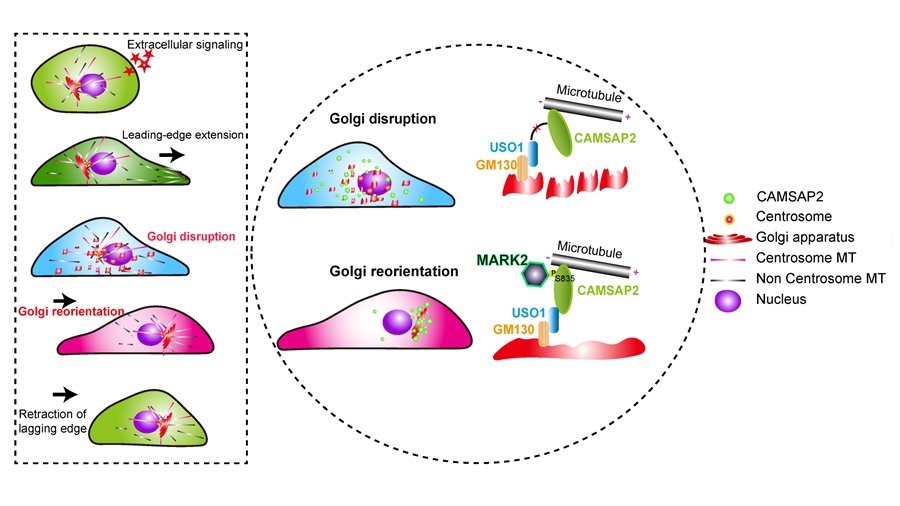Cell migration is fundamental to various physiological processes, including embryonic morphogenesis, tissue repair, and immune responses. A crucial aspect of directed cell migration is polarized trafficking, in which the Golgi apparatus acts as a central hub, sorting newly synthesized membranes and proteins to specific cell regions such as the leading edge. Golgi-derived secretory cargo provides essential membrane materials, cell-surface receptors, and extracellular matrix components required for sustaining the forward movement of migrating cells. Despite the recognized importance of Golgi reorientation, the polarity signaling pathways governing this process remain poorly characterized.
On March 26, 2025, a research team led by MENG Wenxiang at the Institute of Genetics and Developmental Biology (IGDB), Chinese Academy of Sciences, published a groundbreaking study titled "MARK2 regulates Golgi apparatus reorientation by phosphorylation of CAMSAP2 in directional cell migration" in eLife (DOI:10.7554/eLife.105977.1). This research, for the first time, identifies a key regulatory pathway involving the Golgi-associated protein CAMSAP2, which anchors non-centrosomal microtubules, in the reorientation of the Golgi apparatus during directed cell migration.
The researchers discovered that CAMSAP2 localization at the Golgi apparatus dynamically changes during cell migration. MARK2, a crucial kinase in establishing cellular polarity, phosphorylates CAMSAP2 at the serine residue S835, thereby modulating its interaction with the Golgi matrix protein USO1. In the absence of phosphorylation, CAMSAP2's affinity for USO1 diminishes, disrupting the polarized distribution of CAMSAP2-anchored non-centrosomal microtubules around the Golgi. This disturbance impairs Golgi reorientation and consequently affects directional cell migration.
This study significantly advances our understanding of the molecular mechanisms underlying Golgi reorientation. Moreover, it provides an essential theoretical basis for future therapeutic strategies targeting cell migration in physiological and pathological contexts, such as wound healing, immune surveillance, cancer metastasis, atherosclerosis, and inflammatory joint diseases.
Grants from the National Key R&D Program of China and the National Natural Science Foundation of China supported this work.
Figure. MARK2 regulates Golgi apparatus reorientation by phosphorylation of CAMSAP2 in directional cell migration. (Image by IGDB)
Contact:
Dr. MENG Wenxiang
Institute of Genetics and Developmental Biology, Chinese Academy of Sciences
Email: wxmeng@genetic.ac.cn
 Figure. MARK2 regulates Golgi apparatus reorientation by phosphorylation of CAMSAP2 in directional cell migration. (Image by IGDB)Contact:Dr. MENG WenxiangInstitute of Genetics and Developmental Biology, Chinese Academy of SciencesEmail: wxmeng@genetic.ac.cn
Figure. MARK2 regulates Golgi apparatus reorientation by phosphorylation of CAMSAP2 in directional cell migration. (Image by IGDB)Contact:Dr. MENG WenxiangInstitute of Genetics and Developmental Biology, Chinese Academy of SciencesEmail: wxmeng@genetic.ac.cn CAS
CAS
 中文
中文




.png)
